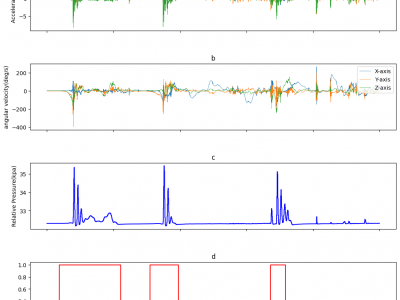.pkl

A collection of Python pickles objects containing a Pandas DataFrame. Each Dataframe corresponds to the postprocessed firing rate (fr) in Hz and mean amplitude of the spikes (AMP) in microV/s of the vagus nerve recordings obtained from 12 adult female Sprague-Dawley rats. Additionally, the blood-glucose level in mg/dL is included. The fr and AMP signals have 0.1 miliseconds of resolution, whereas the glucose level was measured approximately every 5 minutes. Temporal variations are due to experimental factors. The number of available glucose samples changes across recordings.
- Categories:
 45 Views
45 Views
We proposes a new task in the field of Answering Subjective Induction Question on Products (SUBJPQA). The answer to this kind of question is non-unique, but can be interpreted from many perspectives. For example, the answer to ‘whether the phone is heavy’ has a variety of different viewpoints. A satisfied answer should be able to summarize these subjective opinions from multiple sources and provide objective knowledge, such as the weight of a phone.
- Categories:
 19 Views
19 ViewsThe data was collected by outfitting one of the players with the experimental balloon, which incorporated the embedded circuit and sensors. The sensors positioned at the top-right to the player within the bubble balloon, where a player stand inside. The sensors' data were collected at specific sampling frequencies (Accelerometer: 1000Hz, Gyroscope: 1000Hz, and Pressure: 40Hz). The experiment was conducted involving five different players. This approach allowed for the inclusion of diverse data samples, taking into account variations in player metrics, movements, and gameplay dynamics.
- Categories:
 213 Views
213 ViewsThe results are based on the measurements conducted on small drones and a bionic bird using a 60 GHz millimeter wave radar, analyzing their micro-Doppler characteristics in both time and frequency domain. The results are presented in .pkl format. The more detailed description of the data and how the authors processed it will be updated soon.
- Categories:
 1617 Views
1617 ViewsThe dataset consists of undirected weighted multi-graphs stored in .pkl or .net formats. These undirected graphs form instances for the multi-trip multi-depot rural postman problem. The Multi-trip multi-depot Rural Postman Problem is a variant of the Capacitated Arc Routing Problem which is to find a set of routes for vehicles having limited capacity to traverse a set of arcs from a node called depot in an undirected graph in the least possible time. The dataset consists of instances generated by modifying instances from the literature and also real-world road networks.
- Categories:
 218 Views
218 Views

SCVIC-CIDS-2021 was created using the raw data in CIC-IDS-2018*, while this new dataset, SCVIC-CIDS-2022 is formed from NDSec-1** meta-data by following a similar procedure.
This dataset has been used in the following work:
J. Liu, M. Simsek, B. Kantarci, M. Bagheri, P. Djukic, "Bridging Networks and Hosts via Machine Learning-Based Intrusion Detection"; under review in IEEE Transactions on Dependable and Secure Computing.
- Categories:
 1175 Views
1175 Views
SCVIC-CIDS-2021 is a novel dataset that combines network- and host-based data.
SCVIC-CIDS-2021 is derived from the meta-data (i.e., network packets, system logs and labeling information) from the well-known benchmark dataset, CIC-IDS-2018 (Iman Sharafaldin, Arash Habibi Lashkari, and Ali A. Ghorbani, “Toward Generating a New Intrusion Detection Dataset and Intrusion Traffic Characterization”, 4th International Conference on Information Systems Security and Privacy (ICISSP), Portugal, January 2018 ) .
- Categories:
 1216 Views
1216 Views
This is the simulated post fault voltage magnitude transient data from the IEEE 118-bus system. The data is collected from the TSAT software (DSATool). This transient data is used to mimic the PMU voltage measurements. This file has three folders. The first folder 'Train_Test' has the training and testing data. The dimension of the training data 'Pro2_train_v.pkl' and testing data 'Pro2_test_v.pkl' are (8000x25x20) and (2000x25x20), respectively. Here the number of training and testing samples is 8000 (4000 stable, 4000 unstable) and 2000 (1000 stable and 1000 unstable).
- Categories:
 907 Views
907 ViewsThis dataset consists of measurements from a foot-mounted inertial measurement unit (IMU). In total, we provide data from five different test subjects travelling over more than 7.6 km. The data are combined with various forms of ground truth positioning information that can be used to evaluate the accuracy of a zero-velocity-aided, foot-mounted inertial navigation system (INS).
- Categories:
 1781 Views
1781 Views


